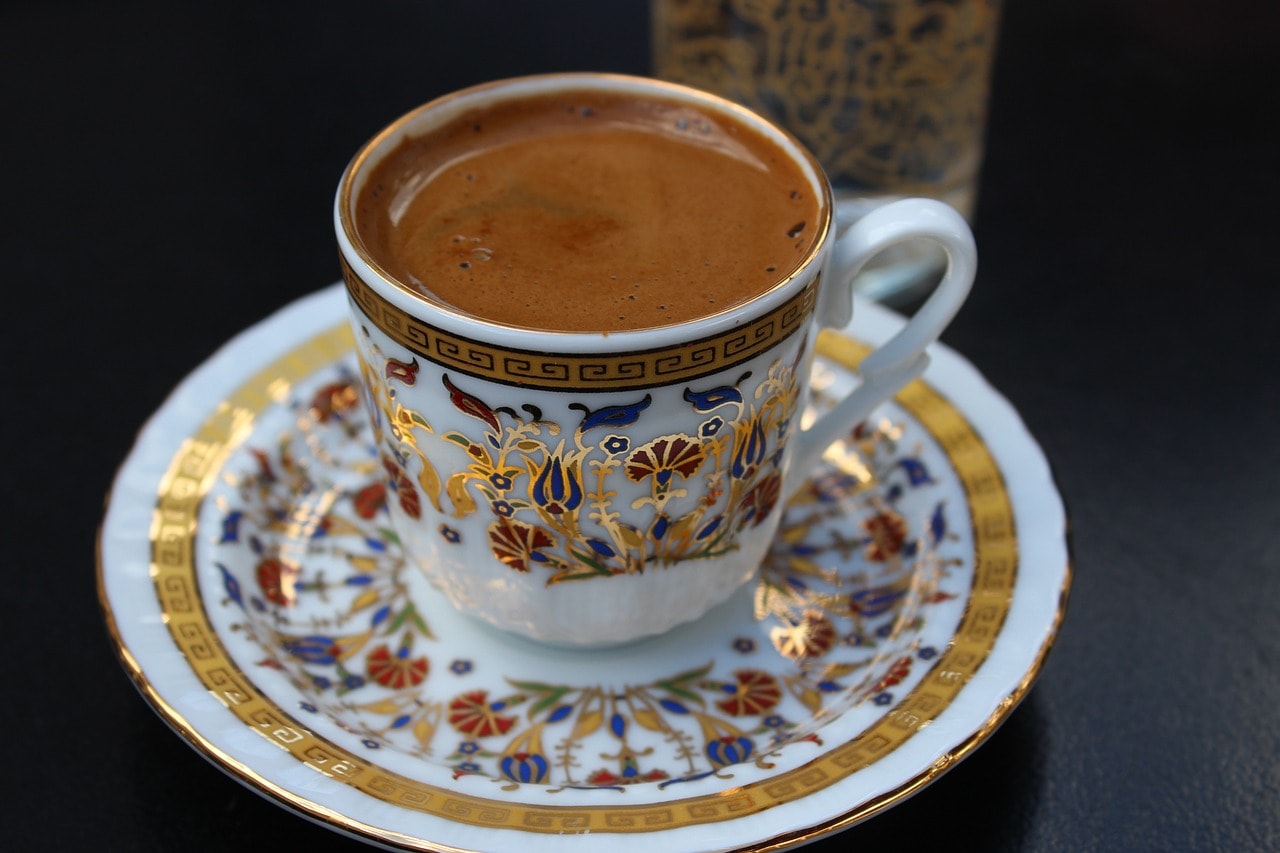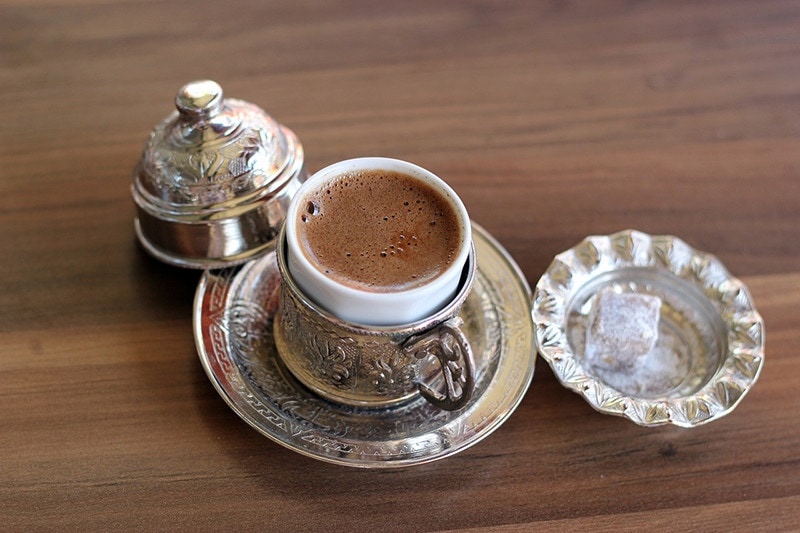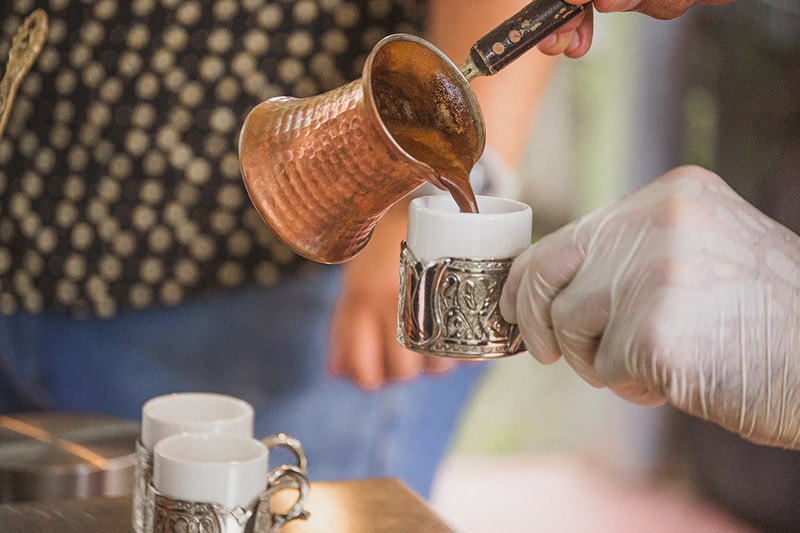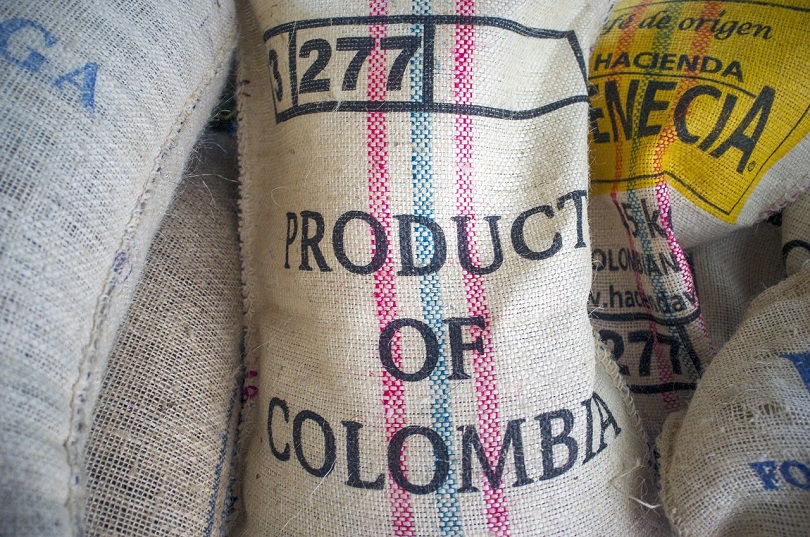
Turkish coffee, which not surprisingly is incredibly popular in Turkey, is also relatively popular in the United States among folks who love rich, delicious coffee. Made with a specialized copper pot known as a cezve, Turkish coffee is served in demitasse cups which the brewer fills slowly and gently to keep coffee grounds out of the finished drink.
The taste, if you’ve never tried Turkish coffee, is uniquely intense, which is why it’s usually served with a Turkish sweet and a glass of water. How much caffeine is in Turkish coffee? Typically, there are about 50 to 65 milligrams (mg) in a 2–5 ounce demitasse cup. That is only slightly more than a cup of regular black coffee. If you’re curious about Turkish coffee and how it stacks up to other coffee drinks, read on.

How Much Caffeine Does Turkish Coffee Contain?
Like the regular black coffee, we all know and love, Turkish coffee typically has a low amount of caffeine, between 40 and 60 milligrams. However, that amount can increase significantly if, for example, the person brewing the Turkish coffee uses more coffee in their cezve. It stands to reason that the more coffee that’s used, the higher the concentration of caffeine will be imparted in the finished drink.
The typical amount of ground coffee in a Turkish coffee is 1 teaspoon, but just as with regular coffee, you’re free to use more (or less) if desired. That said, if you use a single teaspoon of ground coffee in your Turkish coffee, the amount of caffeine you’ll be getting is around 50 to 60 milligrams.

Turkish Coffee Caffeine Content vs American Coffee
As we’ve seen, a demitasse cup of Turkish coffee has about 50 to 60 milligrams of caffeine. You might wonder how that stacks up against your favorite coffee and coffee drinks, like a cappuccino or flat white coffee.
| Coffee Drink | Caffeine Content |
| Turkish Coffee | 50–60 mg |
| Cappuccino | 60–75 mg |
| Cold Brew Coffee | 110–155 mg |
| Espresso | 60–75 mg |
| Frappuccino | 40–65 mg |
| Flat White Coffee | 110–130 mg |
| Iced Coffee | 100–120 mg |
| Instant Coffee | 40–63 mg |
| Latte | 60–80 mg |
All About Turkish Coffee
What Is Turkish Coffee?
Turkish coffee, at least in Turkey, is an integral part of the culture that’s been handed down for centuries. What’s fascinating is that while Turkish coffee is made from regular Arabica coffee beans, the process used to make it is unique. The process of making Turkish coffee is so unique that the United Nations Educational, Scientific, and Cultural Organization (UNESCO) placed the drink on its Intangible Cultural Heritage List in 2013.
That process starts similarly to regular American coffee in that the Arabica beans are ground to a fine powder, usually with a specialized Turkish coffee grinder. The powder is then added to cold water in the device used to heat and brew the coffee: the cezve. The cezve is then placed over medium heat until the coffee begins foaming, after which it’s removed from the heat and stirred.
However, at this point, the Turkish coffee still isn’t finished. It’s returned to the heat, reheated to foaming, taken off, and stirred again. This happens several times until the coffee is very thick, at which time it’s taken off the heat and left to cool for a few minutes. This also allows the coffee grounds to fall to the bottom of the cezve.
The now-ready Turkish coffee is poured slowly into demitasse cups to avoid stirring up the grounds that have settled. If you want sugar in your Turkish coffee, it must be added before brewing so that you don’t need to stir it into the prepared coffee (and risk stirring up the grounds). Last but certainly not least, Turkish coffee is slowly sipped and never drank quickly, as is the custom in Turkey. Always remember that drinking Turkish coffee quickly is seen as impolite.


Fun Facts About Turkish Coffee
The grounds Can Tell Your Future
Many fortune tellers in Turkey read fortunes from the grounds left behind in a demitasse Turkish coffee cup.
Brides Prepare It for Their Prospective In-Laws
Brides-to-be in Turkey will make Turkish coffee when they first meet their future in-laws. It’s said that a woman who can brew a good cup of Turkish coffee is ready to be married.
Turkish Coffee Is Really Strong
That’s because it’s heated and reheated until a good bit of the water boils off.
The First Coffeehouses in Turkey Appeared in the 16th Century
They were around during the Ottoman Empire and were places where storytellers would preserve the history of their country and people.
Menengiç Coffee Is a Turkish Coffee That Contains No Caffeine
That’s because it’s made from the beans of the Pistacia terebinthus tree.
For Turkish coffee, the Arabica Beans Are Ground Very Finely
In most cases, they’re ground as finely as baby powder.

Final Thoughts
Turkish coffee, at least initially, isn’t much different from American coffee and, surprisingly, is made with Arabica beans. However, the way Turkish coffee is prepared is what sets it apart, in texture and flavor, from the coffee we drink here in the United States. It’s thicker, more bitter, and very strong.
Of course, many Turkish people living here in the U.S. enjoy Turkish coffee, which has become popular in larger American cities, especially those with a large Turkish population. If you ever have the chance, try a demitasse full of Turkish coffee. Just be sure to drink it slowly and enjoy it thoroughly with good friends and conversation.
- https://www.nescafe.com/in/turkish-coffee
- https://www.coffee-direct.co.uk/blogs/coffee-q-and-as/how-strong-is-turkish-coffee#:~:text=Generally%2C%20a%20cup%20of%20Turkish,as%20low%20as%2040%20mg.
- https://www.healthline.com/nutrition/how-much-caffeine-in-coffee
- https://www.illy.com/en-us/coffee/coffee-preparation/how-to-make-turkish-coffee#:~:text=Preparing%20Turkish%20Coffee%3A,teaspoon%20of%20coffee%20per%20cup
- https://www.unesco.org/en
Featured Image Credit: FatihTurkmen, Pixabay














